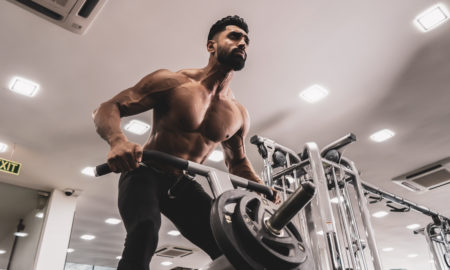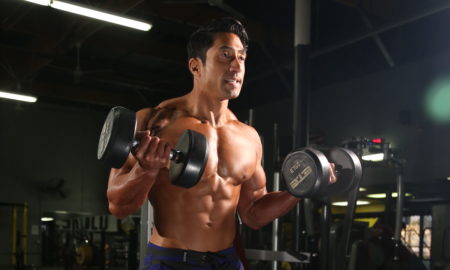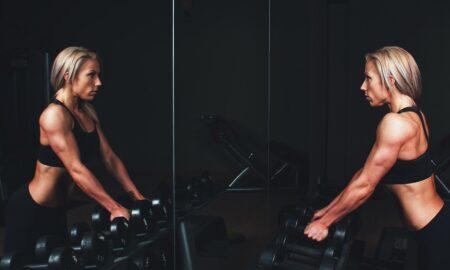

Growing bigger arms may be a motivator to work out constantly. To achieve the boiling point of perfection, you need to understand the various hacks to try out to accelerate your progress.
Bodybuilding your upper arm is an intricate balancing act that features not just weight lifting. Other areas that will need improving include nutrition, adjusting your sets and reps, taking rest days, and more.
The most important thing to remember during this process is nothing ever happens overnight.
With that said, read on to fine-tune your habits so that you safely increase your upper arm muscle mass.

Your Upper Arm Muscles
The upper arm comprises five muscles in the region between your shoulder and elbow. These are spread between two compartments – an anterior and posterior compartment.
The Anterior Compartment
There are three muscles in the anterior compartment:
Biceps gets its name because it has two heads – a long and short head. Activation of both heads primarily flexes the elbow joint.
Running medially on the upper arm is coracobrachialis. This muscle originates on the scapula and attaches midway to the humerus. Upon activation, its primary action is adduction – bringing the arm toward the body from the T-stance.
Finally, underneath all these is brachialis. It originates on the humerus and inserts on the forearm. It works alongside the bicep to flex the elbow.
The Posterior Compartment
Only two muscles are found posteriorly. However, as they are large, they are potent antagonists of muscles in the anterior compartment.
The largest of all is the triceps brachii, which has three heads that unite before inserting behind the elbow. On activation, the triceps straighten the elbow but are also a weak shoulder adductor.
The second muscle, anconeus, is found behind the elbow and runs on the posterior surface of the forearm. When activated, it stabilizes the elbow.
Now that you have a clear picture of your upper arm’s anatomy, here are some pointers to what you should improve on to get optimal muscle hypertrophy.
Consume Plenty Protein
For a long time, bodybuilders have preached the benefits of increasing daily protein intake mainly because they are the key players in stimulating muscle mass.
The physiology of muscle hypertrophy is simple. Each time you work out, muscles endure stress that causes microscopic damage. Growth occurs when protein is used to repair these pressure areas, resulting in increased mass.
As such, proteins should comprise a considerable percentage of your diet if you want to grow bigger muscles.
There are various great sources of protein you can get – both from plant and animal sources. But you may ask, how much protein do I need daily?
The baseline for the average population is about 0.3-0.8 grams per body weight. However, leading nutritionists argue that this is very low and insufficient to sustain muscle growth.
In this line, many lifters take on average 1.4 to 2 grams per kilogram of body weight (0.6g per pound) each day. The correlation of protein and workout volume is direct; as you increase exercise intensity, so should the protein you consume.
A great way to add to your diet is to use protein concoctions. Keep in mind that they should be used to supplement your diet. However, this doesn’t mean that there are adverse downsides to using protein shakes.
On the contrary, protein shakes and smoothies can be tailored to supplement deficits in your diet. For example, one cup taken before or after a workout offers up to 25g of protein to your daily allowance.
Protein shakes have more than enough protein content to take your performance to the moon.
Indeed, several studies show that supplementing your diet with protein shakes can improve your performance, endurance, and muscle mass.
Increase your Volume of Training
It is pretty surprising that devotion to the same routine over and over can be detrimental to your upper arm bulking objectives. Consider the following perspective:
Each day you set to complete 12 pullups and three sets. From the onset, it may be hard to complete each set in the correct form effectively, but as you improve, so does your physique, strength, and endurance.
Finally, one day you hit all three sets effortlessly and are ecstatic about your achievement. However, your body also adapts to your current routine.
Therefore, whatever happens next is pivotal!
You may choose to stick to the same routine or switch things up in several ways. On the one hand, you may decide to increase the number of sets and reps. On the other hand, you can add a new workout, for example, bicep curls or overhead presses.
Ultimately, the change you wish to see is in your hands, and your determination to push harder will make you grow bigger and stronger upper arms.
Vary your Sets and Reps
Our bodies are impeccable at adapting, and once you get used to specific workout routines, you hit a fitness plateau. As earlier said, adjusting the number of reps and sets is one way of growing beyond this dreaded stagnation phase.
But first, let’s talk about the fitness cycle. Each time you exercise, your muscles will tire at first but quickly adapt in the coming days. With time, executing the range of motion will be straightforward, but the same cannot be said for muscle growth.

It has been known that rep ranges between 8-12 are ideal for stimulating endurance and muscle hypertrophy. However, did you know that there are other ways you can change your sets and reps for optimal muscle growth?
To maximize your endurance, you need to do more reps. This means working out with lighter weights so that you can also increase the rep count.
For example, using lightweight dumbbells will allow you to hit as much as 20 bicep curls while still maintaining your form and tempo.
The opposite also holds for strength training, where 4-6 reps are ideal.
Heavier weights and fewer reps are recommended to increase muscle power and strength. Taking the weight you lift a notch higher means that your muscles will be burning and longing for a recovery phase when you reach the fifth rep.
This variation of sets and reps is the basis behind drop sets, supersets, spotted reps, forced reps, cheat reps, and half reps. Here is the breakdown:
Drop sets – Lift weights to failure and reduce your weight and then push again to failure.
Supersets – Create a workout routine with 2-3 different workouts, and hit each complete set back to back without resting.
Spotted reps – Say you can bench press five times, but a set has five repetitions. From the sixth rep onward, a spotter pulls some weight to completion.
Forced reps – In this case, you lift more weight, but the spotter helps you throughout all the reps.
Cheat reps – Here, you execute workouts by moving out of form a bit. For example, you flare your elbows when performing a close grip bench press.
Half reps – You stick to perfect form but half the range of motion.
Not to take away from what we have already covered so far, but setting your workouts based on fixed numbers is ineffective. At the end of the day, you need to always control your muscle growth.
Feel free to adjust the number of reps, sets, and the weight you push to get the best results when you feel like you are not giving your best and vice versa.
Use Blood Flow Restriction Training
Implied by the name, blood flow restriction training involves cutting off blood supply to specific muscle compartments.
The exact technique originates from Japan, where it is known as KAATSU training. Basically, a cuff or tourniquet is applied proximally to the muscle being trained, in this case, muscles of the upper arm. The cuff is then inflated to specific pressures to occlude the veins while performing low-intensity workouts.
While this may seem like torture, the physiology is quite interesting. Muscle hypertrophy is a result of increased cell size as well as protein remodeling. When a muscle is under tension, hormones are released to mediate the growth process.
In the same manner, cellular swelling caused by the pooling of blood causes tension that stimulates hypertrophy of muscle fibers
Therefore, by regulating the supply of blood to upper arm muscles, you have intricate control of the growth process. As such, you will only have to lift a fraction of the weight you would on a typical day to promote the same growth. Additionally, this technique recruits fast-twitch fibers essential for upper arm growth.
This workout technique is recommended to facilitate the recovery of muscles while also promoting bulking. However, to get optimal outcomes, schedule your routines into a superset so that all muscle compartments are extensively worked.
The Bottomline
If you want to build bigger arms, it is ideal to customize your workouts such that a large volume of exercises focus on your arms.
In the ideal scenario, use compound movements that activate several muscle compartments in one motion. One way of effecting this is mastering perfect form, for example, so that your arms are also engaged when you are training your chest.
To get the most out of each workout, hold your nutrition as important as your workouts. Muscles need an adequate supply of protein to grow, and therefore when you are looking to develop more giant arms, precedence should be the way you eat.
Most importantly, keep your workouts simple, and modify your reps and sets each time you reach your fitness peak.






















You must be logged in to post a comment Login